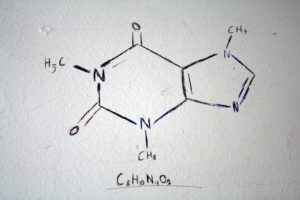Playlist
Show Playlist
Hide Playlist
Oxidation – Carbonyl Compounds
-
Slides 07 Chemistry Advanced Le Gresley.pdf
-
Download Lecture Overview
00:01 Okay. Oxidation. Aldehydes, as we’ve seen before, are readily oxidised and ketones are oxidised with considerable difficulty. If we go back to when we were looking at alcohols, we showed that it was possible to oxidise the alcohol first up to an aldehyde, if it was primary, and then all the way up to a carboxylic acid. If on the other hand we had a secondary alcohol, we could get it as far as the ketone, but we couldn’t oxidise it any further. If we look at aldehydes, there are a number of different ways in which you can convert it to a carboxylic acid. Exhaustive oxidation with potassium permanganate, shown on the top, potassium dichromate and also, in this particular case, a silver diamine nitrate which is otherwise known as Tollen’s reagent which is a characteristic test for the presence of aldehydes since the silver+ becomes reduced and then coats the inside of the tube in the presence of an aldehyde. 01:02 The oxidation can only occur in the case of ketones under severe conditions to give a mixture of acids which are of little synthetic use since you effectively split the entire molecule apart. Let’s have a look at reduction. We’ve already seen chemical reduction using sodium borohydride and lithium aluminium hydride. 01:21 However, it is also possible to reduce ketones and aldehydes via catalytic amounts of nickel, platinum or palladium shown here as Ni, Pt or Pd in the presence of hydrogen gas. And these are able to reduce ketones and aldehydes down to alcohols. 01:44 This is of particular importance when you don’t necessarily want to use an aggressive reducing agent which may perhaps reduce another part of your molecule which you want to keep and hydrogenation can be the best choice when you have other groups that would react with a more aggressive hydride-based reducing agent like lithium aluminium hydride or sodium borohydride. 02:08 Carbonyl compounds are reduced to alcohols and in this particular case, ketones would be reduced to secondary alcohols and aldehydes would be reduced to primary alcohols.
About the Lecture
The lecture Oxidation – Carbonyl Compounds by Adam Le Gresley, PhD is from the course Organic Chemistry.
Included Quiz Questions
Which of the following statements about oxidation reactions of ketones and aldehydes is wrong?
- Ketones are the best substrates to produce pure organic acids via a severe oxidation process.
- Aldehydes give faster oxidation reactions than ketones.
- Primary alcohols get oxidized to aldehydes, whereas oxidation of secondary alcohols results in ketone formation.
- Ketones under severe oxidation conditions give rise to a mixture of acids.
- KMnO4, K2Cr2O7, and [Ag(NH3)2]NO3 are used in the oxidation of aldehydes to acids.
In a silver mirror test, aldehydes react with which of the following?
- [Ag(NH3)2]NO3
- KMnO4
- K2Cr2O7
- CH3OH
- HCOOH
In a qualitative analysis, the silver mirror test helps to determine the presence of which of the following?
- Aldehydes in the test solution.
- Alcohols in the test solution.
- Ketones in the test solution.
- Acids in the test solution.
- [Ag(NH3)2]NO3 in the test solution.
Formaldehyde, aldehydes (other than formaldehyde) and ketones react with hydrogen gas in the presence of the catalytic amounts of nickel or platinum or palladium to give which of the following?
- Methyl, primary and secondary alcohols respectively via reduction reaction.
- Methyl, secondary and primary alcohols respectively via reduction reaction.
- Acids via oxidation reaction.
- Primary, secondary and tertiary alcohols via oxidation reaction.
- Tertiary alcohols via oxidation reaction.
Customer reviews
5,0 of 5 stars
| 5 Stars |
|
5 |
| 4 Stars |
|
0 |
| 3 Stars |
|
0 |
| 2 Stars |
|
0 |
| 1 Star |
|
0 |




